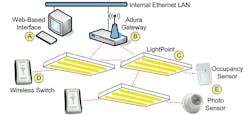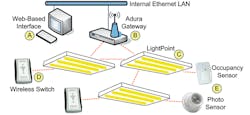Where Wireless Lighting is Headed
Since the 1970s, lights at University of California, Berkeley's Moffitt Undergraduate Library illuminated the facility 24/7—even when the building was closed—because some of its original systems infrastructure was locked in an electrical closet. Today, that same building is on the cutting edge of lighting technology, using a wireless lighting control system that gives the building manager and building occupants control over their spaces. The system can also be programmed to turn on and off or to dim based on the time of day or building occupancy. The technology is based on research by Charlie Huizenga, a research specialist at Berkeley's Center for the Built Environment.
While wireless lighting products have been on the residential market for several years, the technology for commercial buildings is relatively new. Until recently, retrofitting buildings like UC Berkeley's Moffitt Undergraduate Library with wireless controls was considered too complicated and cost prohibitive. Today, however, wireless systems are proving to be cost efficient enough for commercial buildings of all sizes, says Francis Rubinstein, a researcher at Lawrence Berkeley National Laboratory's Environmental Energy Technologies Division.
"It's been too expensive to retrofit existing buildings with energy-saving controls because of the cost of adding wires," says Rubinstein. "Wireless technologies help solve that problem by replacing physical wiring with radio waves. Using wireless switches and dimmers, it is becoming affordable for occupants to control building lighting."
Rubinstein, along with research partner Dennis DiBartolomeo, developed WiLight, a prototype wireless lighting control system designed to make battery-free lighting easy and inexpensive. Using self-powered wireless sensors, WiLight dims or switches overhead lighting according to preference or in response to building-wide demand.
Using WiLight, building occupants will be able to switch and dim overhead illumination wirelessly by using a battery-less transmitter, while a radio bridge allows building managers to manually control the system; the lights can also respond to a signal from a demand-response server instead.
Other wireless products use Web-based radio controls to send messages to transmitting nodes integrated into each lighting fixture so that facility managers can program lighting schedules based on the time of day or occupancy.
Other systems use existing power-line infrastructure to optimize lighting.
"Dimming, in the past, has been an expensive feature typically used in conference rooms," says Gary Robinson, director of business development at Universal Lighting Technologies, Nashville, TN. But, he indicates that it's now more affordable for many other types of rooms.
While wireless lighting technologies vary in cost depending on the particular product and on building size, its cost and energy savings can be significant. "It's [only] a few more years until wireless lighting is totally widespread," says Huizenga. "We're on the leading edge, and wireless lighting is showing huge potential."
Mindi Zissman is a contributing editor at Buildings magazine.

